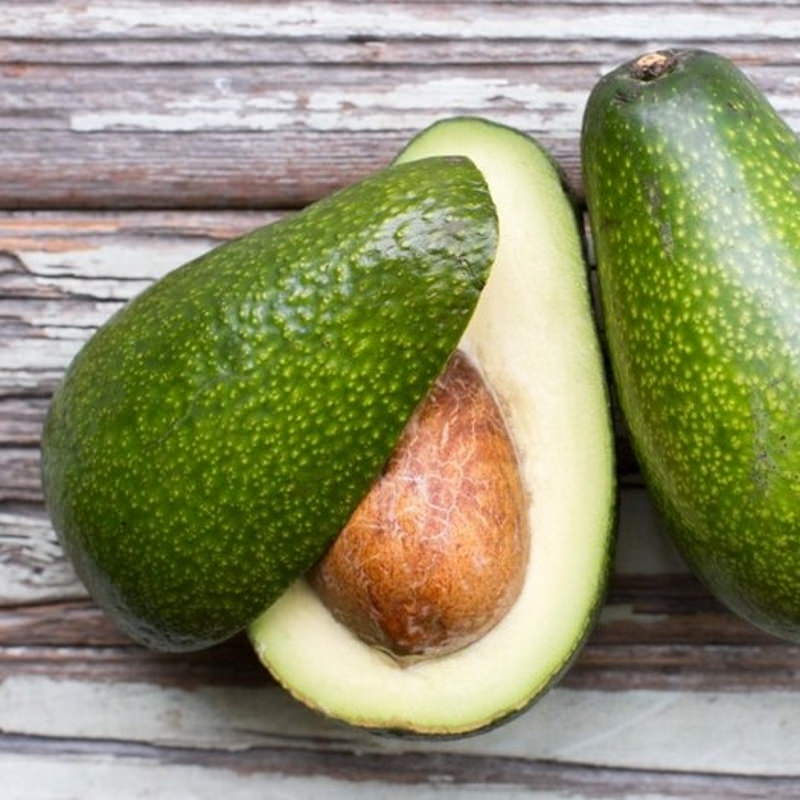
Zutano Avocado – A Rare Tasty Delight
The Zutano Avocado is not an avocado you would find in the grocery store. One reason is that it is used as a pollinator for the Hass avocado and other more popular avocados and not planted in large numbers in the grove. Another is that it is a “green” avocado. Unlike Hass, green avocados stay green when ripe, and consumers prefer the color change, as with the Hass, to know when the avocado is ripe. Hass type avocados are easier to market than green types, regardless of flavor or quality.
Zutano Avocado – Great Taste and Low Oil Content
The Zutano Avocado is similar to the Fuerte avocado with its pear shape and thin, glossy green-yellowish skin. It remains green even when ripe. It has low oil content but packs a pungent avocado taste (with the addition of a lighter, almost lemony top note) and a lighter, silkier texture than the creamy Hass.
Availability and Seasons
The Zutano avocados are available from mid-fall through late winter.
A Southern California Native
The Zutano avocado was developed in Fallbrook, California, at the hands of R.L. Ruitt in 1926.
Farmers have noticed that Hass avocado trees near a Zutano avocado tree regularly have significantly larger fruit set than those planted farther away. Subsequently, some growers are planting Zutano trees around the edge of their Hass avocado grove and pruning to prevent fruit set but to provide flowers for cross-pollination.
Can take the Cold
The Zutano is a cold-hardy Mexican variety. It is widely planted in the San Joaquin Valley, where it is too cold for the Hass (Guatemalan variety) in the winter.
Tree Growth
Zutano avocado tree will grow 30-40 feet in height with a trunk diameter of up to 2 feet at maturity, growing upright with a rounded shape and spreading branches. The tree has oval-shaped, dark green leaves with a glossy sheen. Flowers are a greenish-white, bearing in clusters at the branch tips.
- Sausage and Pepper Hash – An Easy Sheet Pan Dinner
- Avocado Friday! Produce Pop Up Market at Artisan’s Palate Temecula
- Moringa Leaves – 5 Reasons It’s a True Superfood
- Rough Lemon – A Rare and Unique Citrus
- Swiss Chard with Onions and Vinegar
- Edible Flowers – Not Just a Modern Food Trend
- Beet Hummus – High In Nutrition, Fiber, and Protein
- Cheddar Beet Risotto – Sweet and Creamy
- Lemony Kale and Quinoa – A Flavor-Packed Dish
- Dehydrating Herbs for Year-Round Flavor
- Garlic Roasted Carrots and Green Beans – Healthy Side Dish
- Fuyu Persimmon – A Popular Harvest2U Organic Fruit

I live in Chula Vista south of San Diego 4 miles from the ocean would this be a good choice for my yard?
Yes Steve, perfect choice, but I would add a Hass Avocado for cross-pollination.
If you leave zutanos on the tree until April or May, the watery-ness goes away; they have high fat content and great flavor.
Great tip Douglas! Thank you!
How old do they they start producing avocados?
From seed – 10 to 15 years. From nursery stock – 3 to 5.
We planted an avocado from seed and the fruit looks like it could be zutano. It’s just under 4 years old and has around 100 avocados on the tree. Last year it only gave us 1. I know this is anomaly for most avocados planted from seed, but it really likes it here. How can you tell a zutano from a bacon from a fuerte?
Avocados after four years of planting? That is amazing! All Avocados are hybrids. They do not reproduce true to the parent. You have a new variety. Very cool. Now if it’s a great avocado you can propagate it asexually. That is by cuttings or grafting your tree onto another rootstock. Please let us know how they turn out.
Yes, it’s crazy. We actually had it grafted and didn’t protect the shoots very well and the sun baked them. We were so bummed. However, it bounced back! Now we’re just counting our days until we can harvest. How will I know when they’re ripe and/or ready to pull off the tree?
Grafted? The new tree you grew from seed? By grafting onto your new tree, you lose the unique variety you have. I hope you took slips from the new tree and grated those onto another rootstock. You’ll have to experiment. I’d pick when they are a good size. Let them ripen on the counter. Hass type varieties will get darker, but most are ripe when they are soft. They don’t ripen on the tree. and you can pretty much keep them on as long as you want.
Great article! We found some Zutanos at a roadside stand while riding our bikes in Ojai. Looking forward to trying them when they are ripe in a few days.
Thank you. Enjoy!
We had it grafted but they didn’t make it. So now we only have the new hybrid, whatever it is. New to growing avocados, but very excited about our little tree
And you get to name the new variety. Please let us know how it goes with your new tree. Keep us posted. Pictures would be great.
Great article! We just moved to a property in Temecula with 200 avocado trees. A few are Hass and the rest are Zutanos. I notice the Zutano trees are producing much more fruit than the Hass’s. Is that typical for this time of year?
Yes Zutano is more hardy and productive than Hass, but do not command the same market price.
Randy,
We just planted an avocado tree and it turned out to be a Zutano (we thought we were getting a Haas), Will it self pollinate? We do not have room for a second avocado tree!
Thanks, Mindy
Mindy, I believe you planted an avocado tree because they grow in your area. If so do not worry your Zutano will get pollinated. And no it is not self pollinated. Here’s a great explaination on avocado pollination. https://homeguides.sfgate.com/avocado-trees-type-b-flowers-59769.html
Wow, I think our taste buds differ quite a bit. I spit out Zutanos. They are crap avocados. Watery. “Creamy”? my ass. They aren’t delicious.
Of course I’m quite partial to the Hass. Nothing beats it. Highest oil content of any large cultivar. There are some Hass crosses grown here on the Central Coast that have funny sounding names (I forget them) that claim to have higher oil content, but frankly I’ve tried most of them and don’t notice difference in oil. But they are also fruitier, which personally I don’t like. I like the buttery thick Hass meat. Best guacamole from Hass. The downside is Hass isn’t available year round. During the coldest part of the winter and early to mid spring I resort to Hass from Mexico or Mexicola from Mexico which is a world better than any green skin avocado like the Zutano. I’ve occasionally had a decent Ettinger but they are rarely good. Mostly they get defects and browning areas before they lose their wateriness.
Hello Randy! Happy to find your site and learn from the comments, questions and answers here. In winter 2017/2018 I had three avocados (15 gallon containers) planted in my small Central California back yard—a Stewart, a Zutano and a Haas. Last spring (2021) both the Stewart and Zutano finally bloomed and had a few fruits that did not make it. This spring (2022) both trees bloomed profusely and both were LOADED with fruits, which was thrilling. In a recent two-day timeframe, squirrels stripped the Zutano by chewing through the stems about two inches above the fruits and threw them all to the ground without even biting into them (they were about two to three inches long). Now they are going after the Stewart. The Haas has never bloomed (yet). What can I do about these vermin? Will a bird net work after fruit set next spring? Is there a product to buy that would help or might work? I’ve seen a couple of things advertised in gardening catalogs. Tried one (primarily contained cayenne pepper powder and put it on the fence rails), but it didn’t seem to make a difference. They plague me from spring till my fruit is gone early to mid-summer. I was really looking forward to avocados for the first time this year. It’s so disheartening.
Also, what’s the best timing and type for fertilizing avocados? I’ve mulched them heavily since they were originally planted and add fallen leaves ongoing. Ae there any good videos out there on pruning avocados? I need to keep them in the five to six-foot height range so I can manage them. It’s a small back yard and they’re all close to the fences, otherwise I’d be tempted to get a dog to try and chase the squirrels away. Unfortunately, they can just jump from fences to trees with ease. Any suggestions are greatly appreciated. Thanks!
Kim, that’s a bummer. I feel your pain. First, don’t fertilize your Avos. Providing a layer of permanent mulch/compost is more than enough for your trees. Pruning after harvest is fine and they’ll respond well to it. Just do what I call a browse prune. Prune only the outer 2 to 4 inches (or enough to keep them at your height).
As far as the squirrels go… They were wreaking havoc on my orchard and crops until I found this nonpoisonous control method. I use 3 parts dry oatmeal to 1 part Plaster of Paris. Mix well. To keep it out of reach of dogs (they’ll eat it), place it in a 4″ PVC Tee container. The bottom is about 2 feet with a one-foot vertical tube (in the middle of the two-foot bottom tub) and a cap to place the bait in. When the squirrels (and rats and mice) eat it, the bait hardens in their stomachs and they… well, die. If an Owl, Hawk, or coyote eats them (squirrels, rats, and mice), they only get a small amount of calcium. No systemic environmental harm.
You have to stay vigilant and always keep the tubes filled with one cup of bait.
When I started my farm area (and no, my dog was not catching them) with this method, it looked like a Disney theme with squirrels frolicking everywhere. It seemed hopeless. They were eating everything. As an organic farmer, I had to find a better way to control them. Now… it’s a ghost town.